Interpretable Wind Power Short-Term Power Prediction Model Using Deep Graph Attention Network
Abstract
1. Introduction
1.1. Background
1.2. Related Works
1.3. Research Contributions
- Compared with the traditional wind power time series prediction modeling, this paper uses GAT-LSTM as the main method to construct a spatial-temporal prediction model. Firstly, the GAT can extract the information of nodes and edges on the graph and increase the attention of important information between nodes through the attention mechanism and pass the extracted features to the LSTM. Then, the LSTM model performs temporal learning on the extracted features and establishes a prediction model that satisfies the learning target ability.
- The stochastic search algorithm is applied to the GAT-LSTM prediction model for model hyperparameter optimization, and a multifactor-driven wind power spatial-temporal prediction model is established.
- Adding attention mechanism to the prediction model, on the one hand, can increase the attention ability of the wind power prediction model to important features and then improve the prediction accuracy of the model. On the other hand, through the dynamic change of the attention weight and the visualization of weight, it can provide a basis for the interpretability of the model more intuitively.
2. Materials and Methods
2.1. Graph Convolution Network
2.2. Long Short-Term Memory Neural Network
2.3. Graph Attention Mechanism
2.3.1. Attention Mechanism
2.3.2. Graph Attention Mechanism
2.4. Random Search Optimization Hyperparameters
3. Wind Power Output Prediction Process
3.1. Wind Power Prediction Model Framework
3.2. Evaluation Indicators
4. Case Analysis
4.1. Data Sets and Experimental Environment
4.2. Comparative Analysis of Model Prediction Results
- The model proposed in this paper has better prediction performance. Experiments show that the integrated prediction algorithm proposed in this paper can extract the spatial-temporal correlation of different input features more deeply and obtain the model output with higher accuracy. The possible reason is that the integrated model combines the advantages of multiple single models, which makes the model have better feature extraction ability and nonlinear mapping ability and improves the overall data extraction ability and prediction performance of the model.
- Compared with other models, the graph network model with attention mechanism can better express the relationship between different input feature nodes through self-learning so that the model has better generalization performance. Compared with other models, it has stronger spatial-temporal feature extraction ability, which confirms the effectiveness of the model’s prediction method.
5. Model Interpretability
5.1. Interpretability in Time Dimension
5.2. Interpretability in Spatial Dimension
6. Conclusions and Future Work
- The model proposed in this paper is higher than the existing model in terms of the prediction accuracy, indicating that the model can more fully mine the spatial-temporal characteristics of the multi-factor characteristics of the target wind farm.
- Under the complex meteorological conditions of wind power generation, the GAT can better aggregate and extract the key information of the original multi-input features and more deeply mine the spatial-temporal characteristics of the original features. It provides a new solution to solve the problem of multi-factor feature modeling for wind power prediction.
- The model applies the attention mechanism to obtain interpretability from the spatial and temporal dimensions. Because of the strong volatility of wind power, the long-term information has little reference significance to the model, which leads to the model paying more attention to the time step close to the predicted target time. The graph node structure self-learnt by the graph network structure shows the feature information that wind power prediction pays more attention to. The visualization of model details and the more transparent operation mechanism also bring greater application value to power grid operation scheduling and wind power consumption.
Author Contributions
Funding
Data Availability Statement
Conflicts of Interest
Abbreviations
| GNN | Graph neural network |
| LSTM | Long short-term memory |
| NWP | Numerical weather prediction |
| RNN | Recurrent neural network |
| CNN | Convolutional neural network |
| GCN | Graph convolutional network |
| GAT | Graph attention network |
| SCADA | Supervisory control and data acquisition |
| TCN | Time convolutional network |
| GRU | Gated recurrent unit |
| ARIMA | Autoregressive integrated moving average |
References
- Moayyed, H.; Moradzadeh, A.; Mohammadi-Ivatloo, B.; Aguiar, A.P.; Ghorbani, R. A Cyber-Secure generalized supermodel for wind power forecasting based on deep federated learning and image processing. Energy Convers. Manag. 2022, 267, 115852. [Google Scholar] [CrossRef]
- Zhang, J.; Liu, L.; Liu, Y.; Zhu, Y.; Yan, J. Research on Robust Model Predictive Control Strategy of Wind Turbines to Reduce Wind Power Fluctuation. Electr. Power Syst. Res. 2022, 213, 108809. [Google Scholar] [CrossRef]
- Liu, H.; Duan, Z. Corrected multi-resolution ensemble model for wind power forecasting with real-time decomposition and Bivariate Kernel density estimation. Energy Convers. Manag. 2020, 203, 112265. [Google Scholar] [CrossRef]
- Xu, Y.; Jia, L.; Yang, W. Correlation based neuro-fuzzy Wiener type wind power forecasting model by using special separate signals. Energy Convers. Manag. 2022, 253, 115173. [Google Scholar] [CrossRef]
- Yan, J.; Zhang, J.; Liu, Y.; Han, S.; Li, L.; Gu, C. Unit commitment in wind farms based on a glowworm metaphor algorithm. Electr. Power Syst. Res. 2015, 129, 94–104. [Google Scholar] [CrossRef][Green Version]
- Sun, S.; Wang, T.; Yang, H.; Chu, F. Condition monitoring of wind turbine blades based on self-supervised health representation learning: A conducive technique to effective and reliable utilization of wind energy. Appl. Energy 2022, 313, 118882. [Google Scholar] [CrossRef]
- Hoolohan, V.; Tomlin, A.S.; Cockerill, T. Improved near surface wind speed predictions using Gaussian process regression combined with numerical weather predictions and observed meteorological data. Renew. Energy 2018, 126, 1043–1054. [Google Scholar] [CrossRef]
- Allen, D.J.; Tomlin, A.S.; Bale, C.S.E.; Skea, A.; Vosper, S.; Gallani, M.L. A boundary layer scaling technique for estimating near-surface wind energy using numerical weather prediction and wind map data. Appl. Energy 2017, 208, 1246–1257. [Google Scholar] [CrossRef]
- Aasim; Singh, S.N.; Mohapatra, A. Repeated wavelet transform based ARIMA model for very short-term wind speed forecasting. Renew. Energy 2019, 136, 758–768. [Google Scholar] [CrossRef]
- Krishna Rayi, V.; Mishra, S.P.; Naik, J.; Dash, P.K. Adaptive VMD based optimized deep learning mixed kernel ELM autoencoder for single and multistep wind power forecasting. Energy 2022, 244, 122585. [Google Scholar] [CrossRef]
- Yesilbudak, M.; Sagiroglu, S.; Colak, I. A novel implementation of kNN classifier based on multi-tupled meteorological input data for wind power prediction. Energy Convers. Manag. 2017, 135, 434–444. [Google Scholar] [CrossRef]
- Zendehboudi, A.; Baseer, M.A.; Saidur, R. Application of support vector machine models for forecasting solar and wind energy resources: A review. J. Clean. Prod. 2018, 199, 272–285. [Google Scholar] [CrossRef]
- Shi, Z.; Liang, H.; Dinavahi, V. Direct Interval Forecast of Uncertain Wind Power Based on Recurrent Neural Networks. IEEE Trans. Sustain. Energy 2018, 9, 1177–1187. [Google Scholar] [CrossRef]
- Zhang, J.; Yan, J.; Infield, D.; Liu, Y.; Lien, F.-S. Short-term forecasting and uncertainty analysis of wind turbine power based on long short-term memory network and Gaussian mixture model. Appl. Energy 2019, 241, 229–244. [Google Scholar] [CrossRef]
- Lin, Z.; Liu, X. Wind power forecasting of an offshore wind turbine based on high-frequency SCADA data and deep learning neural network. Energy 2020, 201, 117693. [Google Scholar] [CrossRef]
- Cheng, L.; Zang, H.; Xu, Y.; Wei, Z.; Sun, G. Augmented Convolutional Network for Wind Power Prediction: A New Recurrent Architecture Design with Spatial-Temporal Image Inputs. IEEE Trans. Ind. Inform. 2021, 17, 6981–6993. [Google Scholar] [CrossRef]
- Nikodinoska, D.; Käso, M.; Müsgens, F. Solar and wind power generation forecasts using elastic net in time-varying forecast combinations. Appl. Energy 2022, 306, 117983. [Google Scholar] [CrossRef]
- Zhang, Y.-M.; Wang, H. Multi-head attention-based probabilistic CNN-BiLSTM for day-ahead wind speed forecasting. Energy 2023, 278, 127865. [Google Scholar] [CrossRef]
- Shan, Y.; Hu, J.; Shen, B. Distributed Secondary Frequency Control for AC Microgrids Using Load Power Forecasting Based on Artificial Neural Network. IEEE Trans. Ind. Inform. 2023, 1–11. [Google Scholar] [CrossRef]
- Yildiz, C.; Acikgoz, H.; Korkmaz, D.; Budak, U. An improved residual-based convolutional neural network for very short-term wind power forecasting. Energy Convers. Manag. 2021, 228, 113731. [Google Scholar] [CrossRef]
- Wang, C.-H.; Zhao, Q.; Tian, R. Short-Term Wind Power Prediction Based on a Hybrid Markov-Based PSO-BP Neural Network. Energies 2023, 16, 4282. [Google Scholar] [CrossRef]
- Zhu, Q.; Chen, J.; Shi, D.; Zhu, L.; Bai, X.; Duan, X.; Liu, Y. Learning Temporal and Spatial Correlations Jointly: A Unified Framework for Wind Speed Prediction. IEEE Trans. Sustain. Energy 2020, 11, 509–523. [Google Scholar] [CrossRef]
- Chen, Y.; Zhang, S.; Zhang, W.; Peng, J.; Cai, Y. Multifactor spatio-temporal correlation model based on a combination of convolutional neural network and long short-term memory neural network for wind speed forecasting. Energy Convers. Manag. 2019, 185, 783–799. [Google Scholar] [CrossRef]
- Liu, Y.; Qin, H.; Zhang, Z.; Pei, S.; Jiang, Z.; Feng, Z.; Zhou, J. Probabilistic spatiotemporal wind speed forecasting based on a variational Bayesian deep learning model. Appl. Energy 2020, 260, 114259. [Google Scholar] [CrossRef]
- Chowdhury, P.N.; Shivakumara, P.; Kanchan, S.; Raghavendra, R.; Pal, U.; Lu, T.; Lopresti, D. Graph attention network for detecting license plates in crowded street scenes. Pattern Recognit. Lett. 2020, 140, 18–25. [Google Scholar] [CrossRef]
- Huang, H.; Zhu, Q.; Zhu, X.; Zhang, J. An Adaptive, Data-Driven Stacking Ensemble Learning Framework for the Short-Term Forecasting of Renewable Energy Generation. Energies 2023, 16, 1963. [Google Scholar] [CrossRef]
- Severiano, C.A.; de Lima e Silva, P.C.; Weiss Cohen, M.; Guimarães, F.G. Evolving fuzzy time series for spatio-temporal forecasting in renewable energy systems. Renew. Energy 2021, 171, 764–783. [Google Scholar] [CrossRef]
- Yu, R.; Liu, Z.; Li, X.; Lu, W.; Ma, D.; Yu, M.; Wang, J.; Li, B. Scene learning: Deep convolutional networks for wind power prediction by embedding turbines into grid space. Appl. Energy 2019, 238, 249–257. [Google Scholar] [CrossRef]
- Chen, W.; Jiang, M.; Zhang, W.-G.; Chen, Z. A novel graph convolutional feature based convolutional neural network for stock trend prediction. Inf. Sci. 2021, 556, 67–94. [Google Scholar] [CrossRef]
- Zhao, L.; Song, Y.; Zhang, C.; Liu, Y.; Wang, P.; Lin, T.; Deng, M.; Li, H. T-GCN: A Temporal Graph Convolutional Network for Traffic Prediction. IEEE Trans. Intell. Transp. Syst. 2020, 21, 3848–3858. [Google Scholar] [CrossRef]
- Tao, S.; Zhang, H.; Yang, F.; Wu, Y.; Li, C. Multiple Information Spatial–Temporal Attention based Graph Convolution Network for traffic prediction. Appl. Soft Comput. 2023, 136, 110052. [Google Scholar] [CrossRef]
- Zhang, J.; Meng, H.; Gu, B.; Li, P. Research on short-term wind power combined forecasting and its Gaussian cloud uncertainty to support the integration of renewables and EVs. Renew. Energy 2020, 153, 884–899. [Google Scholar] [CrossRef]
- Chen, J.; Zhu, Q.; Shi, D.; Li, Y.; Zhu, L.; Duan, X.; Liu, Y. A Multi-Step Wind Speed Prediction Model for Multiple Sites Leveraging Spatio-temporal Correlation. Proc. CSEE 2019, 39, 2093–2106. [Google Scholar]
- Yu, C.; Yan, G.; Yu, C.; Zhang, Y.; Mi, X. A multi-factor driven spatiotemporal wind power prediction model based on ensemble deep graph attention reinforcement learning networks. Energy 2023, 263, 126034. [Google Scholar]
- Abou Houran, M.; Salman Bukhari, S.M.; Zafar, M.H.; Mansoor, M.; Chen, W. COA-CNN-LSTM: Coati optimization algorithm-based hybrid deep learning model for PV/wind power forecasting in smart grid applications. Appl. Energy 2023, 349, 121638. [Google Scholar] [CrossRef]
- Sun, S.; Liu, Y.; Li, Q.; Wang, T.; Chu, F. Short-term multi-step wind power forecasting based on spatio-temporal correlations and transformer neural networks. Energy Convers. Manag. 2023, 283, 116916. [Google Scholar] [CrossRef]
- Wang, C.; Tian, R.; Hu, J.; Ma, Z. A trend graph attention network for traffic prediction. Inf. Sci. 2023, 623, 275–292. [Google Scholar] [CrossRef]
- Bentsen, L.Ø.; Warakagoda, N.D.; Stenbro, R.; Engelstad, P. Spatio-temporal wind speed forecasting using graph networks and novel Transformer architectures. Appl. Energy 2023, 333, 120565. [Google Scholar] [CrossRef]
- Yuan, X.; Chen, C.; Jiang, M.; Yuan, Y. Prediction interval of wind power using parameter optimized Beta distribution based LSTM model. Appl. Soft Comput. 2019, 82, 105550. [Google Scholar] [CrossRef]
- Sun, R.; Zhang, T.; He, Q.; Xu, H. Review on Key Technologies and Applications in Wind Power Forecasting. High Volt. Eng. 2021, 47, 1129–1143. [Google Scholar]
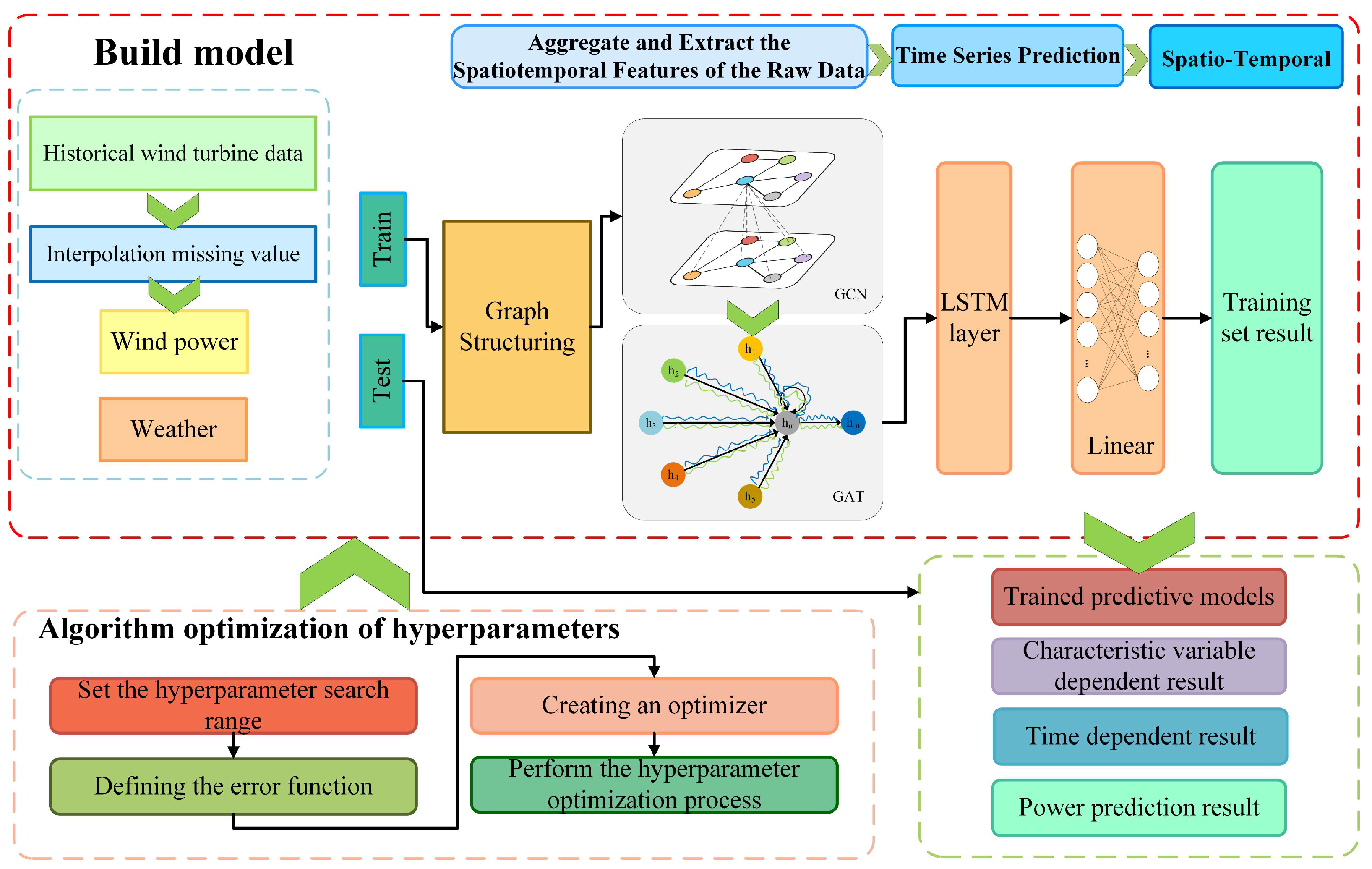
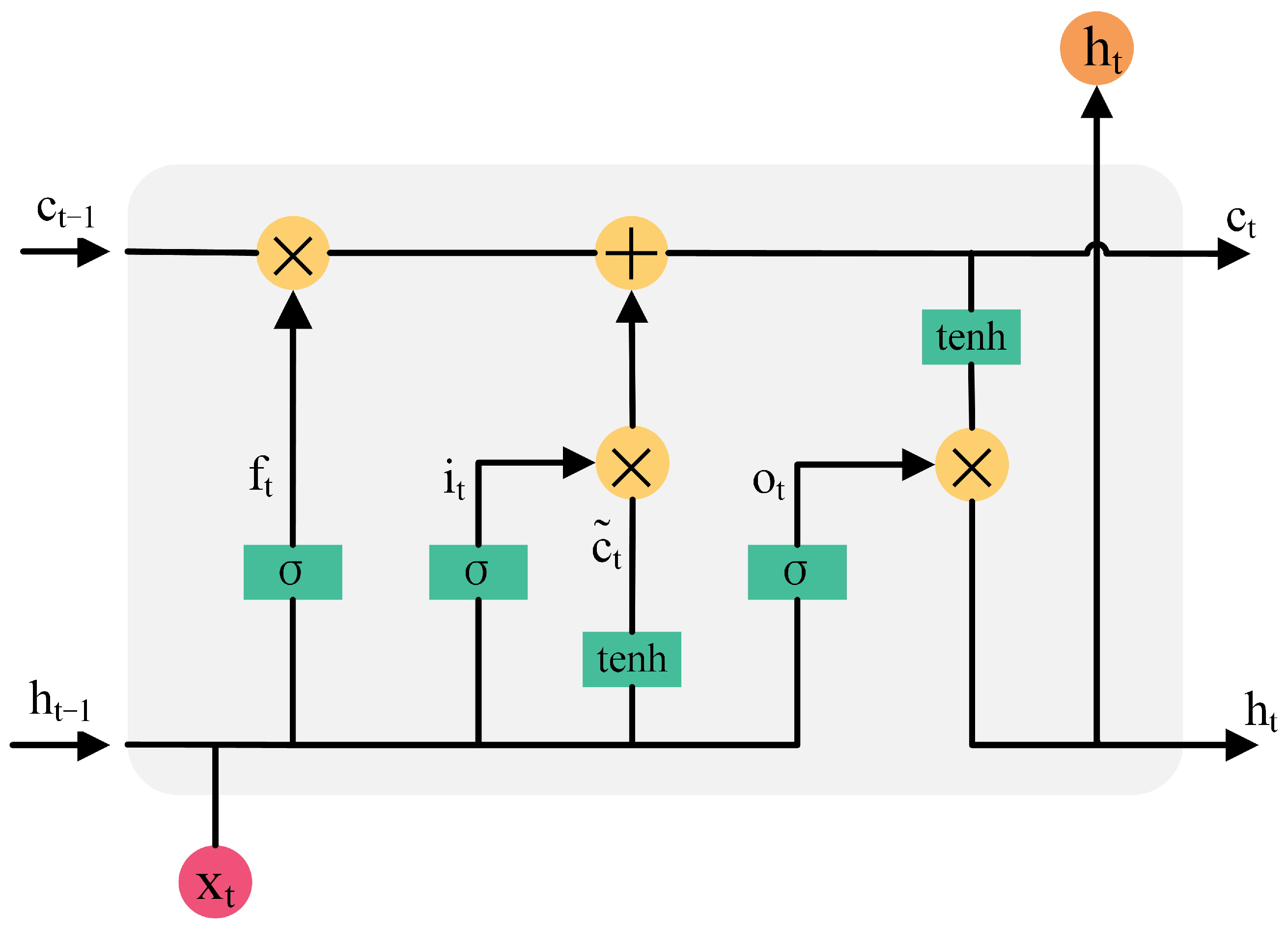

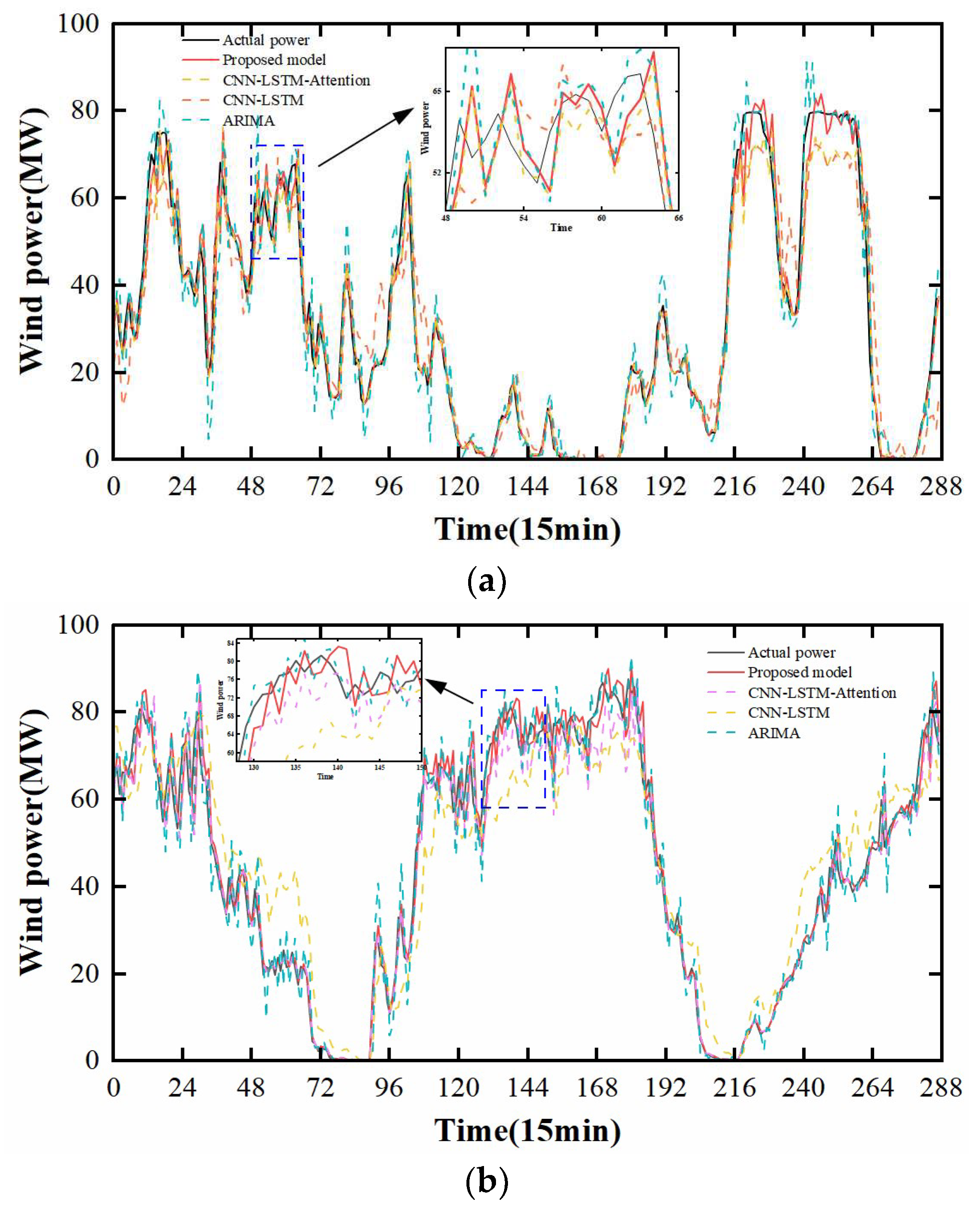
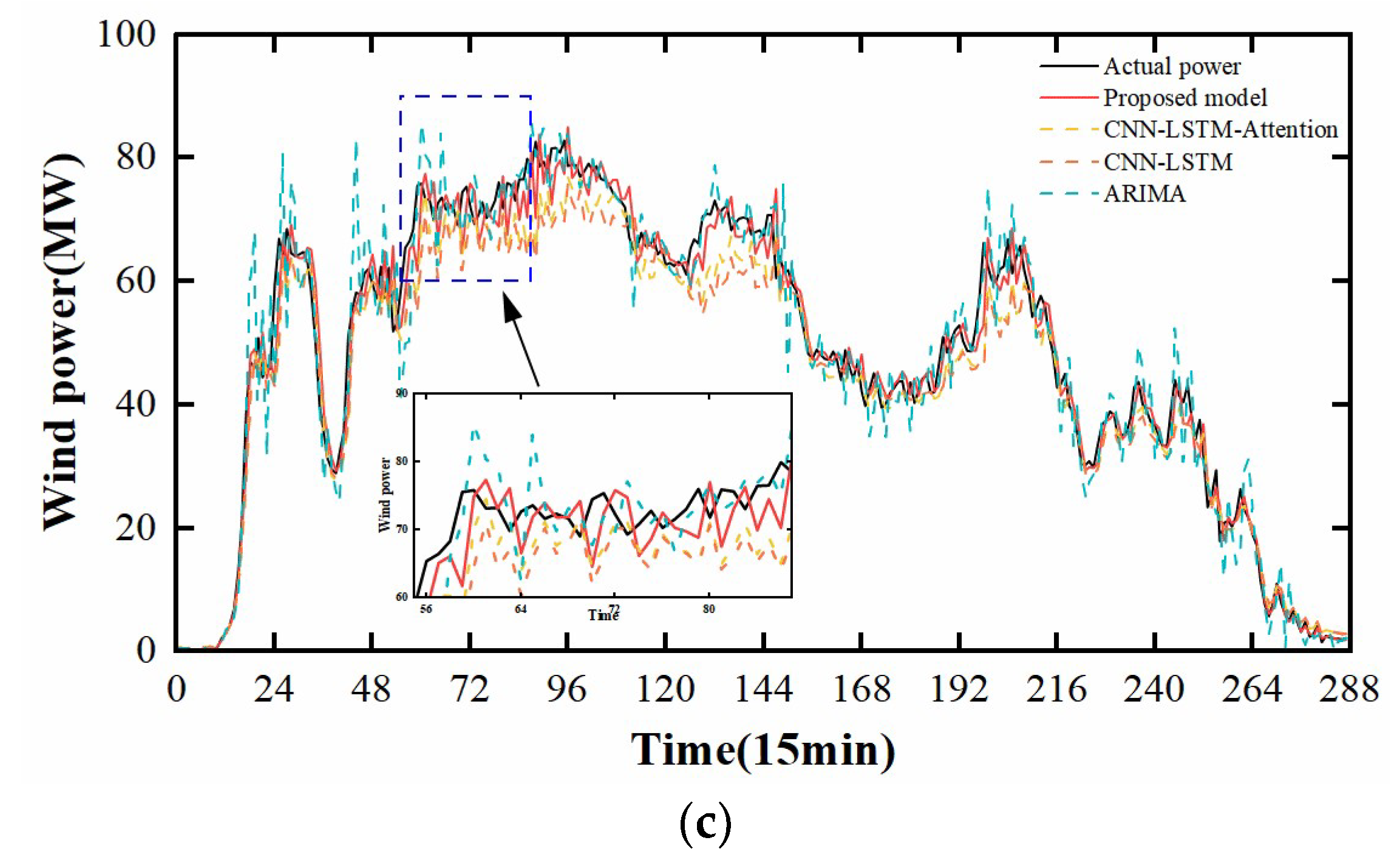

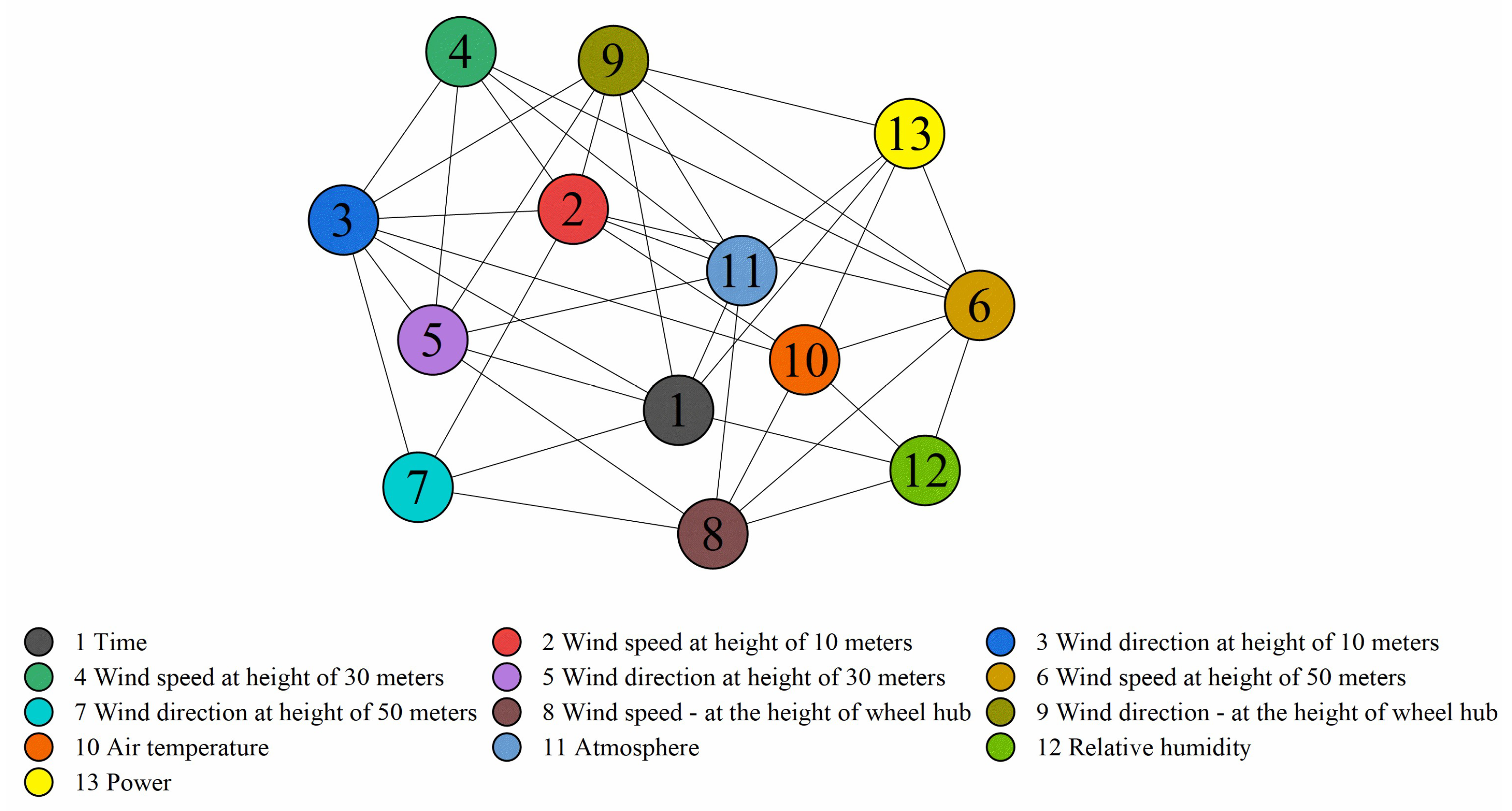
| Wind Farm | Generating Capacity (MW) | Wind Turbine Model | Capacity (KW) | Hub Height (m) | Rotor Diameter (m) | Number of Turbines |
|---|---|---|---|---|---|---|
| Farm site 1 | 75 | GW1500/85 1 | 1500 | 85.0 | 87.0 | 50 |
| 24 | H93 L-2.0 2 | 2000 | 85.5 | 93.0 | 12 | |
| Farm site 2 | 49.5 | UP86-1500 3 | 1500 | 80.0 | 86.0 | 33 |
| 49.5 | UP82-1500 3 | 1500 | 80.0 | 82.0 | 33 | |
| Farm site 3 | 96 | XE72 4 | 2000 | 65.0 | 70.7 | 48 |
| Statistics | Wind Speed—Height 50 m (m/s) | Wind Direction—Height 50 m (◦) | Wind Speed—Height of Wheel Hub (m/s) | Wind Direction—Height of Wheel Hub (°) | Air Temp. (°C) | Relative Humidity (%) | |
|---|---|---|---|---|---|---|---|
| Farm site 1 | Mean | 6.169 | 221.868 | 6.376 | 216.986 | 8.543 | 37.581 |
| Std. | 3.874 | 83.092 | 3.908 | 85.40 | 13.368 | 18.896 | |
| Min. | 0.000 | 0.000 | 0.000 | 0.000 | −24.131 | 1.502 | |
| Max. | 29.678 | 358.933 | 30.247 | 358.500 | 36.130 | 93.120 | |
| Farm site 2 | Mean | 4.933 | 143.019 | 5.231 | 179.949 | 17.511 | 58.809 |
| Std. | 3.241 | 93.321 | 3.299 | 110.123 | 9.838 | 23.501 | |
| Min. | 0.000 | 0.000 | 0.000 | 0.000 | −14.27 | 3.437 | |
| Max. | 21.836 | 360.0 | 36.920 | 360.0 | 36.32 | 100.0 | |
| Farm site 3 | Mean | 7.436 | 87.778 | 8.145 | 94.145 | 21.158 | 78.649 |
| Std. | 3.592 | 89.135 | 3.797 | 91.294 | 6.416 | 10.883 | |
| Min. | 0.000 | 0.000 | 0.000 | 0.000 | 0.000 | 0.000 | |
| Max. | 21.81 | 360.0 | 23.82 | 360.0 | 37.13 | 99.38 |
| Farm Site | Model | MSE (MW) | MAE (MW) | R2 |
|---|---|---|---|---|
| Site 1 | Proposed model | 21.823 | 2.808 | 0.962 |
| CNN-LSTM-Attention | 29.527 | 3.389 | 0.949 | |
| CNN-LSTM | 51.329 | 5.899 | 0.901 | |
| ARIMA | 43.976 | 4.517 | 0.931 | |
| Site 2 | Proposed model | 26.792 | 3.691 | 0.951 |
| CNN-LSTM-Attention | 33.459 | 4.926 | 0.934 | |
| CNN-LSTM | 102.906 | 8.301 | 0.864 | |
| ARIMA | 40.338 | 4.486 | 0.925 | |
| Site 3 | Proposed model | 20.642 | 3.212 | 0.968 |
| CNN-LSTM-Attention | 39.386 | 4.531 | 0.939 | |
| CNN-LSTM | 47.315 | 5.019 | 0.927 | |
| ARIMA | 42.919 | 4.324 | 0.935 |
Disclaimer/Publisher’s Note: The statements, opinions and data contained in all publications are solely those of the individual author(s) and contributor(s) and not of MDPI and/or the editor(s). MDPI and/or the editor(s) disclaim responsibility for any injury to people or property resulting from any ideas, methods, instructions or products referred to in the content. |
© 2024 by the authors. Licensee MDPI, Basel, Switzerland. This article is an open access article distributed under the terms and conditions of the Creative Commons Attribution (CC BY) license (https://creativecommons.org/licenses/by/4.0/).
Share and Cite
Zhang, J.; Li, H.; Cheng, P.; Yan, J. Interpretable Wind Power Short-Term Power Prediction Model Using Deep Graph Attention Network. Energies 2024, 17, 384. https://doi.org/10.3390/en17020384
Zhang J, Li H, Cheng P, Yan J. Interpretable Wind Power Short-Term Power Prediction Model Using Deep Graph Attention Network. Energies. 2024; 17(2):384. https://doi.org/10.3390/en17020384
Chicago/Turabian StyleZhang, Jinhua, Hui Li, Peng Cheng, and Jie Yan. 2024. "Interpretable Wind Power Short-Term Power Prediction Model Using Deep Graph Attention Network" Energies 17, no. 2: 384. https://doi.org/10.3390/en17020384
APA StyleZhang, J., Li, H., Cheng, P., & Yan, J. (2024). Interpretable Wind Power Short-Term Power Prediction Model Using Deep Graph Attention Network. Energies, 17(2), 384. https://doi.org/10.3390/en17020384






